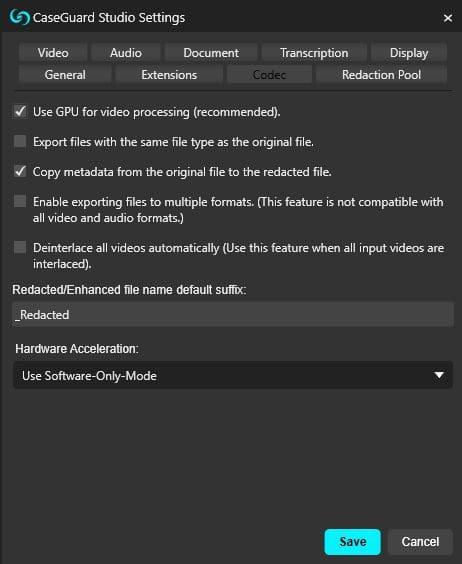How to Access Metadata Within Photos Using CaseGuard
July 19, 2022 | 4 minutes read
As virtually all forms of online or digital interactions can be linked to some form of personal information due to the widespread use of the internet around the world, people must be aware of the data they create when working at their job, shopping for services, and products, and engaging in leisure activities, among other things. To this point, something as simple as taking a photograph of a person or object generates metadata, data that effectively is used to provide information about other forms of data, such as the dimensions of an image. With all this being said, Redaction Studio can be used to access the metadata that is associated with an album of photos or images, ensuring that users can keep track of said data and keep it safe from unauthorized access or use.
CaseGuard Studio Settings

To access the metadata within an album of photographs using CaseGuard Studio, a user must first click the Tools button within the Menu bar, and then click on the Settings option from the proceeding drop-down menu. This will then take users to the Redaction Studio Settings pop-up window. When navigating through this window, users can click on the Codec section to access a variety of different settings pertaining to the file exportation process within the software. This being said, users can check the Copy metadata from the original file to the redacted file option to access the metadata that will be linked to any photos they redact or enhance using the software. After checking this option, users can then click the Save button to apply these changes to the software.

Creating a photo album


After a user has adjusted the metadata settings within CaseGuard Studio, they can then begin redacting or enhancing the photos or images of their choosing. To begin this process, users must first click on the Create Album button within the Shortcuts bar. Clicking this button will open the Create Album pop-up window within the user’s workspace. From within this pop-up window, users can click on the Add Files button to begin importing their photos or images into the software program. After a user has successfully imported their photos into the system, they can begin editing their photos using the numerous redaction and enhancement features within the software.
Automatic detection

To give an example of the image editing features that are contained within CaseGuard Studio, users of the software can automatically redact faces and heads that have been captured in photographs by using the system’s automatic detection feature. To start, users must first click the Automatic Face/Head Detection button, located on the left-hand toolbar. This will then take users to the AI Automatic Detection pop-up window. From within this pop-up window, users can then select the redaction shapes and effects they want to use to remove objects from their photos, such as the Ellipse shape, and the Pixelate visual effect, as well as many other combinations. After a user has selected the redaction shape and visual effect combination of their choosing, they can then click the Apply button to initiate the redaction process.

After a user clicks the Apply button, they will notice that redaction boxes will begin appearing over any faces that are present within the images they have uploaded into the system by clicking the Play button within the media player. After the redaction process has been completed, users can then click the Export button in the upper-right hand corner of the software, which will then take them to the Save as File Name pop-up window. From within this pop-up window, users can click the Export button once again to begin the exportation process within the software. When the export process has finished, users will be able to access their redacted photos by clicking the Open Project Folder button within the Project Files panel, underneath the Export button.


Accessing metadata

After clicking the Open Projet Folder button, users will then be taken to the file explorer on their respective machines. When looking through their file explorer, users should see an album file with Redacted in the title. After clicking on this album, users will be able to access each individual photo they redacted within the software. To access the metadata for a particular photo, users must first right-click on the photo, and select Properties from the drop-down menu. This will then take users to another pop-up window, enabling them to view the metadata for the photo by clicking on the Settings tab. Within the settings tab, users will be able to see the Width and Height of the photo, as well as the Horizontal Resolution of the photo, among other pertinent information.


By simply checking an option within the system’s settings menu, accessing the metadata of photos is made easy when using CaseGuard Studio. While many people may not be aware of the existence of metadata, this information provides users with a wide range of useful information regarding the images or photos they are working with, be it for a personal or professional purpose. In this way, the team at CaseGuard Studio remains dedicated to providing clients with both redaction and enhancement features, as well as editing features that will allow said clients to make changes to content in virtually any file type.